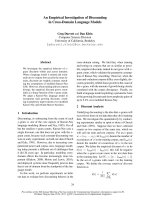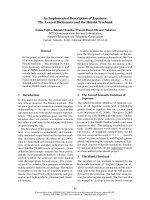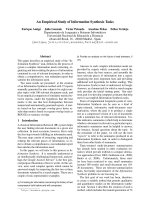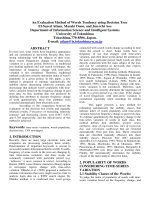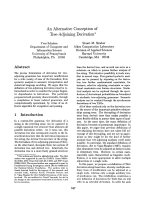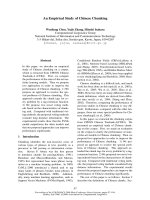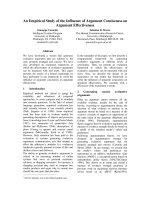Báo cáo khoa học: "An Attributive Logic of Set Descriptions Set Operations" doc
Bạn đang xem bản rút gọn của tài liệu. Xem và tải ngay bản đầy đủ của tài liệu tại đây (759.11 KB, 8 trang )
An Attributive Logic of Set Descriptions
Set Operations
Suresh Manandhar
HCRC Language Technology Group
The University of Edinburgh
2 Buccleuch Place
Edinburgh EH8 9LW, UK
Internet: Suresh. Manandhar@ed. ac. uk
and
Abstract
This paper provides a model theoretic semantics to fea-
ture terms augmented with set descriptions. We pro-
vide constraints to specify HPSG style set descriptions,
fixed cardinality set descriptions, set-membership con-
straints, restricted universal role quantifications, set
union, intersection, subset and disjointness. A sound,
complete and terminating consistency checking proce-
dure is provided to determine the consistency of any
given term in the logic. It is shown that determining
consistency of terms is a NP-complete problem.
Subject Areas: feature logic, constraint-based gram-
mars, HPSG
1 Introduction
Grammatical formalisms such as HPSG
[Pollard and Sag, 1987] [Pollard and Sag, 1992] and
LFG [Kaplan and Bresnan, 1982] employ feature de-
scriptions [Kasper and Rounds, 1986] [Smolka, 1992]
as the primary means for stating linguistic theories.
However the descriptive machinery employed by these
formalisms easily exceed the descriptive machinery
available in feature logic [Smolka, 1992]. Furthermore
the descriptive machinery employed by both HPSG
and LFG is difficult (if not impossible) to state in fea-
ture based formalisms such as ALE [Carpenter, 1993],
TFS [Zajac, 1992] and CUF [D6rre and Dorna, 1993]
which augment feature logic with a type system.
One such expressive device employed both within
LFG [Kaplan and Bresnan, 1982] and HPSG but is
unavailable in feature logic is that of set descriptions.
Although various researchers have studied set de-
scriptions (with different semantics) [Rounds, 1988]
[Pollard and Moshier, 1990] two issues remain unad-
dressed. Firstly there has not been any work on consi-
stency checking techniques for feature terms augmen-
ted with set descriptions. Secondly, for applications
within grammatical theories such as the HPSG forma-
lism, set descriptions alone are not enough since de-
scriptions involving set union are also needed. Thus
to adequately address the knowledge representation
needs of current linguistic theories one needs to provide
set descriptions as well as mechanisms to manipulate
these.
In the HPSG grammar forma-
lism [Pollard and Sag, 1987], set descriptions are em-
ployed for the modelling of so called semantic indices
([Pollard and Sag, 1987] pp. 104). The attribute INDS
in the example in (1) is a multi-valued attribute whose
value models a set consisting of (at most) 2 objects.
However multi-valued attributes cannot be descri-
bed within feature logic [Kasper and Rounds, 1986]
[Smolka, 1992].
(1)
Io DREL 4
°~TIs~R[] /
Ls'~E~ w J
[NDS IRESTINAME
~andy
]['IRESTINAME
kim
II
¢
L L N*M" D JIL L JJJ
A further complication arises since to be able to deal
with anaphoric dependencies we think that set mem-
berships will be needed to resolve pronoun dependen-
cies. Equally, set unions may be called for to incremen-
tally construct discourse referents. Thus set-valued
extension to feature logic is insufficient on its own.
Similarly, set valued subcategorisation frames (see (2))
has been considered as a possibility within the HPSG
formalism.
(2)
believes=
IYNILOCISUBCAT~
[[SYN~LOOIHEADICAT v]
But once set valued subeategorisation frames are em-
ployed,
a set valued analog of the HPSG subcategorisa-
tion principle too is needed. In section 2 we show that
the set valued analog of the subcategorisation principle
can be adequately described by employing a disjoint
union operation over set descriptions as available wit-
hin the logic described in this paper.
2 The logic of Set descriptions
In this section we provide the semantics of feature
terms augmented with set descriptions and various
constraints over set descriptions. We assume an al-
phabet consisting of x, y, z, 6 )2 the set of variables;
f,g, E Y: the set of relation symbols; el, c2, E C
the set of constant symbols; A,B,C, 6 7 ) the set
of primitive concept symbols and a,b, 6 .At the
set of atomic symbols. Furthermore, we require that
/,T E T'.
255
The syntax of our term language defined by the follo-
wing BNF definition:
P > x I a t c I C [ -~x I -~a [ -~c [ -~C
S,T- >
P
f : T feature term
Sf : T existential role quantification
Vf : P universal role quantification
f: {T1, ,Tn} set description
f {T1, ,
Tn}=
fixed cardinality set description
f : g(x) U h(y)
union
f: g(x) rq h(y)
intersection
f :~ g(x)
subset
f(x) # g(y)
disjointness
S Iq T conjunction
where
S, T, T1, , Tn are
terms; a is an
atom; c
is a
constant; C
is a
primitive concept and f
is a
relation
symbol.
The interpretation of
relation symbols and atoms
is
provided by an interpretation Z =</4I I > where/41
is an arbitrary non-empty set and I is an interpretation
function that maps :
1. every relation symbol f • ~" to a binary relation
fl C_/4I x/4I
2. every atom
a • .At
to an element
a I • bl x
Notation:
• Let
if(e)
denote the set {e'[ (e,e') • if}
• Let
fI(e) T
mean
fl(e) = 0
Z is required to satisfy the following properties :
1. if al ~ a2 then
all # hi2 (distinctness)
2. for any atom a • At and for any relation f • ~" there
exists no e • U 1 such that (a,
e) • fl (atomicity)
For a given interpretation Z an Z-assignment a is a
function that maps :
1. every variable x • ]2 to an element a(x) • 141
2. every constant c • C to an element
a(c) •/41
such
that for distinct constants Cl, c2 : a(cl) # a(c2)
3. every primitive concept C • 7 ) to a subset a(C) C
/41 such that:
•
~(_L) = 0
•
a(T) =/41
The interpretation of terms is provided by a denotation
function [[.]]z,a that given an interpretation Z and an
Z-assignment a maps terms to subsets of/41.
The function [.]]z,a is defined as follows :
~x~z,"
= {,~(x)}
[[a]]Z, ~ = {a I}
[cK'"
= {a(e)}
Iv] z,~
=
~(c)
If: T] z'"
=
{e •/411 he' •/4i:
fZ(e )
= {e'} A e' • ~T] z'e}
[3f : T~ :r'a =
{e•/4 llqe'•/4(l:(e,e') •f!
A e' • IT] z'"}
IV f: T]] z'~
=
{e • W' lye' •/41: (e, e') • f1 =~ e' • IfT] z'"}
U: {T,, ,T~}K," =
{e
E U I
[ 9el, ,ge~ e U I :
f1(e) =
{el, ,e,}^
el e IT1] z'a A A e,~ • [T,~] z'~}
If: {T1, , Tn}=] z'a =
{e •/4I I 9el, ,ge~
•/4I
:
Ifl(e) l = n
A
fI(e)
= {el,
,en}A
el • [Tx]Z'a A A e~ • [T,] z'"}
If: g(x) U h(y)]] z'a =
{e • LI I I fl(e) = gl(a(x))
U hI(a(y))}
If: g(x) N h(y)] z'a =
{e •/41 [ fi (e ) = gi (c~(x) ) rq hl (c~(y) ) }
If :~_ g(x)lz, ~' =
{e •
u ~ I f(e) ~ g1(~(x))}
if(x ) #
g(y)]]z,c~ =
• 0
if
fl(a(x))
n
gl(a(y)) # O
• U I if
f1(a(x))
A
g1(a(y)) = 0
IS rl T]] z,a = [[S]] z,a N [T]] z,a
[-~T~ ~," = U' - [T~ z,"
The above definitions fix the syntax and semantics of
every term.
It follows from the above definitions that:
I:T -
/:{T} -I:{T}=
Figure 1
Although
disjoint union
is not a primitive in the logic
it can easily be defined by employing set disjointness
and set union operations:
f: g(x) eJ h(y) =de/ g(x) # h(y) ~q f: g(x) U h(y)
Thus disjoint set union is exactly like set union except
that it additionally requires the sets denoted by
g(x)
and
h(y)
to be disjoint.
The set-valued description of the subcategorisation
principle can now be stated as given in example (3).
(3) Subcategorisation Principle
SYN,LOC Y ]]
TRS X n [HL-DTR[SYN[LOC[SUBCAT c-dtrs(X) ~ subcat(Y)
The description in (3) simply states that the subcat
value of the H-DTR is the disjoint union of the subcat
value of the mother and the values of C-DTRS. Note
that the disjoint union operation is the right operation
to be specified to split the set into two disjoint subsets.
Employing just union operation would not work since
256
Decomposition rules
x=F:TAC~
(DFeat) x=F:yAy=TACs
if y is new and T is not a variable and F ranges over Sf, f
x = Vf : ~ A C~
(DForall) x=Vf:yAy=~ACs
if y is new and ~ ranges over a, c.
(DSet) x = f: {Ti, ,T~} A C~
x = I: {xl, ,x~}^xl =T1 ^ ix~
=T~ACs
if xi, , xn are new and at least one of Ti : 1 < i < n is not a variable
x= f : {Ti, ,T,}=A Cs
(DSetF) x = f
: {Xl, ,
xn}
A
X
= f: {Xl, ,
Xn}=
A X 1 = T 1 ^ i
x n = T n i C s
if xi, , x~ are new and at least one of Ti : 1 < i < n is not a variable
x=SNTAC,~
(DConj)
x = S i x = T A gs
Figure 2: Decomposition rules
it would permit repetition between members of the
SUBCAT attribute and C-DTRS attribute.
Alternatively, we can assume that N is the only multi-
valued relation symbol while both SUBCAT and C-DTRS
are single-valued and then employ the intuitively ap-
pealing subcategorisation principle given in (4).
(4) Subcategorisation Principle
TRS [H-DTRISYNILOCISUBCATIN N(X) ~ N(Y)
C-DTRS X
With the availability of set operations, multi-valued
structures can be incrementally built. For instance, by
employing union operations, semantic indices can be
incrementally constructed and by employing members-
hip constraints on the set of semantic indices pronoun
resolution may be carried out.
The set difference operation f :
g(y) - h(z)
is not avai-
lable from the constructs described so far. However,
assume that we are given the term x R f :
g(y) - h(z)
and it is known that
hZ(~(z)) C_ gZ(a(y))
for every in-
terpretation 27, (~ such that [x R f :
g(y)- h(z)~ z,~ ¢ 0.
Then the term x N f :
g(y) - h(z)
(assuming the ob-
vious interpretation for the set difference operation) is
consistent iff the term y [] g :
f(x) t~ h(z)
is consistent.
This is so since for setsG, F,H:G-F=HAFCG
i]:f
G = F W H. See figure 1 for verification.
3 Consistency checking
To employ a term language for knowledge representa-
tion tasks or in constraint programming languages the
minimal operation that needs to be supported is that
of consistency checking of terms.
A term T is consistent if there exists an interpreta-
tion 2: and an/:-assignment (~ such that
[T] z'a ~ 0.
In order to develop constraint solving algorithms for
consistency testing of terms we follow the approaches
in [Smolka, 1992] [Hollunder and Nutt, 1990].
A containment constraint is a constraint of the
form x = T where x is a variable and T is an term.
Constraint simplification rules - I
x=yACs
(SEquals) x = y A
[x/y]Cs
if x ~ y and x occurs in Cs
(SConst) x=~Ay=~ACs
x=yAx=~ACs
where ~ ranges over a, c.
(SFeat)
x= f :yAx= F :zZACs
x=/:yAy= ACs
where F ranges over f, 3f, Vf
(SExists) x=gf:yAx=Vf:zAC~
x= f :yAy=zACs
(SForallE) x = V__] : C A x = 9f : y A C~_
x
=V/:
CAx = 3/: yAy = CAC~
if C ranges over C, -~C, -~a, c, -~z and
Cs Vy =C.
Figure 3: Constraint simplification rules - I
In addition, for the purposes of consistency checking
we need to introduce disjunctive constraints which
are of the form x Xl U U x,~.
We say that an interpretation Z and an/-assignment
a satisfies a constraint K written 27, a ~ K if.
• Z,a~x=Tv=~a(x) E[T~ z'a
• Z,a~x=xlU Uxn.: ~.a(x)=a(xi)forsome
xi:l <i<n.
A constraint system Cs is a
conjunction
of con-
straints.
We say that an interpretation 27 and an Z-assignment
a satisfy a constraint system
Cs iffZ, a
satisfies every
constraint in Cs.
The following lemma demonstrates the usefulness of
constraint systems for the purposes of consistency
checking.
Lemma 1
An term T is consistent iff there exists a
variable x, an interpretation Z and an Z-assignment a
such that Z, a satisfies the constraint system x = T.
Now we are ready to turn our attention to constraint
solving rules that will allow us to determine the con-
sistency of a given constraint system.
257
Constraint simplification rules - II
(SSetF) x=F:yAx=f:{Xl, ,xn}AC8
x= f :yAy=xlA Ay=xnACs
where F ranges over f, Vf
(SSet) x = f: {y} A C8
x= f :yAC8
(SDup) x=f:{Xl, ,xi, ,xj, ,x,~}AC8
x = f : {Zl, ,x, , ,x,} ^ C8
if
xi x i
(SForaU) x = Vf : CA x = f : {xl, ,xn}
A C8
x =f: =-C^C8
if C ranges over C, -~C, -~a, -~c, -~z and
there exists
xi : 1 < i < n
such that
Cs ~1 xi = C.
x = Bf
: yAx = f : {Xl, ,x,~} A
C8
(SSetE) x=f:{Xl, ,x,~}Ay=xlU UxnAC8
(SSetSet)
X=f:{Xl, ,Xn}AX=f:{yl, ,ym}AC8
x = I:
Xl = Yl II II Ym ^ • ^ Xn = Yl II II ymA
Yl xz [J • II xn A A Ym = Xl II II xn A 68
where n _< m
x= x I II Uxn ACs
(SDis) x = Xl M IJ x~ A x = xi A
C8
ifl <i<nand
there is no
x j, 1 < j < n
such that C8 F x = x:
Figure 4: Constraint
We say that a constraint system C8 is basic if
none
of
the
decomposition rules
(see figure 2) are applicable to
c8.
The purpose of the decomposition rules is to break
down a complex constraint into possibly a number of
simpler constraints upon which the constraint simpli-
fication rules (see figures 3, 4 and 5 ) can apply by
possibly introducing new variables.
The first phase of consistency checking of a term T
consists of exhaustively applying the decomposition
rules to an initial constraint of the form x = T (where
x does not occur in T) until no rules are applicable.
This transforms any given constraint system into
basic
form.
The constraint simplification rules (see figures 3, 4 and
5 ) either eliminate variable equalities of the form x =
y or generate them from existing constraints. However,
they do not introduce new variables.
The constraint simplification rules given in figure 3 are
the analog of the feature simplification rules provided
in [Smolka, 1991]. The main difference being that our
simplification rules have been modified to deal with
relation symbols as opposed to just feature symbols.
The constraint simplification rules given in figure 4
simplify constraints involving set descriptions when
they interact with other constraints such as feature
constraints - rule (SSetF), singleton sets - rule (SSet),
duplicate elements in a set - rule (SDup), universally
quantified constraint - rule (SForall), another set de-
scription - rule (SSetSet). Rule (SDis) on the other
hand simplifies disjunctive constraints. Amongst all
simplification rules - II
the constraint simplification rules in figures 3 and 4
only rule (SDis) is non-deterministic and creates a n-
ary choice point.
Rules (SSet) and (SDup) are redundant as comple-
teness (see section below) is not affected by these rules.
However these rules result in a simpler normal form.
The following syntactic notion of entailment is em-
ployed to render a slightly compact presentation of the
constraint solving rules for dealing with set operations
given in figure 5.
A constraint system
Cs syntactically entails
the (con-
junction of) constraint(s) ¢ if Cs F ¢ is derivable from
the following deduction rules:
1. ¢AC8 F¢
2. C~Fx=x
3. CsFx=y >CsFy=x
4. CsFx=yACsFy=z >CsFx=z
5. Cs F x = -~y > C~ F y = -~x
6. CsFx=f:y >CsFx=3f:y
7. CsFx=f:y >CsFx=Vf:y
8. CsFx=I:{ ,xi, } >C~Fz=3I:zi
Note that the above definitions are an incomplete list
of deduction rules. However C~ I- ¢ implies C~ ~ ¢
where ~ is the semantic entailment relation defined as
for predicate logic.
We write C8 t/¢ if it is not the case that C~ I- ¢.
The constraint simplification rules given in figure 5
deal with constraints involving set operations. Rule
(C_) propagates g-values of y into I-values of x in
the presence of the constraint x = f :_D
g(y).
Rule
258
Extended
(c_) x =
if:
(ULeft) x=
if
Cs
Constraint simplification rules
x = f :D g(y) A C~
f :D g(y) A z = 3f : Yi A Cs
F/x = 3f : yi and
F y = 3g : yi
x = I: g(y) u h(z) A
f: g(y) W h(z) A x = f :D g(y) A Cs
~/ x = f :D g(y)
(URight) x = f: g(y) U h(z) A Cs
x = f: g(y) U h(z) A x = f :D h(z) A Cs
if Cs V z = f :__D
h(z)
(UDown)
x = f: g(y) U h(z) A Cs
x = f : g(y) U h(z) A y = 3g : xi I z = 3h : xi A Cs
if:
• C~/y=3g:xiand
•
Cst/z=3h:xiand
• C~l-x=3f:xi
( nDown )
= f: g(y) n h(z) A
x = f : g(y) n h(z) A y = 3g : xi A z = 3h : xi A C
if:
• (Cs[/y=3g:xiorCsVz=3h:xi) and
• C~Fx=3f:x~
x =
f:
g(y)
n
h(z) A Cs
(nUp) x = f :
g(y) n h(z) A x = 3f : xi A Cs
if:
• Cs ~x=3f:xi
and
• CsFy=3g:xiand
• C~Fz=3h:xi
Figure 5: Constraint solving with set operations
(ULeft)
(correspondingly Rule
(URight))
adds the
constraint x = f :_D
g(y)
(correspondingly x = f :D
h(z))
in the presence of the constraint x = f :
g(y) U
h(z).
Also in the presence of x = f :
g(y) U h(z)
rule
(UDown) non-deterministically propagates an I-value
of x to either an g-value of y or an h-value of z (if
neither already holds). The notation y = 3g : xi ] z =
3h : xi denotes a non-deterministic choice between
y = 3g : x~ and z = 3h : xi. Rule
(nDown)
propaga-
tes an f-value of x both as a g-value of y and h-value of
z in the presence of the constraint x = f :
g(y) n h(z).
Finally, rule (nUp) propagates a common g-value of y
and h-value of z as an f-value of x in the presence of
the constraint x = f :
g(y) n h(z).
4 Invariance, Completeness and
Termination
In this section we establish the main results of this
paper - namely that our consistency checking proce-
dure for set descriptions and set operations is invari-
ant, complete and terminating. In other words, we
have a decision procedure for determining the consi-
stency of terms in our extended feature logic.
For the purpose of showing
invariance
of our ru-
les we distinguish between
deterministic
and
non-
deterministic
rules. Amongst all our rules only rule
(SDis) given in figure 4 and rule
(UDown)
are non-
deterministic while all the other rules are determini-
stic.
Theorem 2 (Invariance)
1. If a decomposition rule
transforms Cs to C~s then Cs is consistent iff C~ is
consistent.
2. Let Z,a be any interpretation, assignment pair and
let Cs be any constraint system.
• If a deterministic simplification rule transforms
Cs to C' s then:
iff p c"
• If a non-deterministic simplification rule applies
to Cs then there is at least one non-deterministic
choice which transforms Cs to C' s such that:
z,a p
iffz, apc;
A constraint system Cs is in normal form if no rules
are applicable to
Cs.
Let
succ(x, f)
denote the set:
succ(x, f) = {y I c8 x = 3f : y}
A constraint system
Cs
in normal form contains a
clash if there exists a variable x in C8 such that
any
of the following conditions are satisfied :
1. C~Fx=al andC~Fx=a2suchthatal ~a2
2. Cs F x = cl and Cs F x = c2
such thatcl ~c2
3. Cs F x = S and Cs F x = -,S
where S ranges over x, a, c, C.
4. CsFx=3f:yandCsFx=a
5. C~ F f(x) ¢ g(y)
and
succ(x, f) n succ(y, g) 7~
6. C~ F x = f: {xz, ,xn}=
and Isucc(x,f) I < n
If Cs does not contain a clash then C~ is called clash-
free.
The constraint solving process can terminate as soon
as a clash-free
constraint system in normal form is fo-
und or alternatively all the choice points are exhau-
sted.
The purpose of the
clash
definition is highlighted in
the
completeness
theorem given below.
For a constraint system
Cs
in normal form an
equiva-
lence relation ~_
on variables occurring in
Cs
is defined
as follows:
x-~ y ifC~ F x = y
For a variable x we represent its equivalence class by
Theorem 3 (Completeness)
A constraint system
Cs in normal form is consistent iff Cs is clash-free.
Proof Sketch:
For the first part, let C~ be a constraint
system containing a clash then it is clear from the de-
finition of clash that there is no interpretation Z and
Z-assignment a which satisfies
Cs.
Let C~ be a clash-free constraint system in normal
form.
We shall construct an interpretation 7~ =< L/R, .R >
259
and a variable assignment a such that T~, a ~ Cs.
Let U R = V U ,4t UC.
The assignment function a is defined as follows:
1. For every variable x in )2
(a) if C8 }- x = a then ~(x) = a
(b) if the previous condition does not apply then
~(x) = choose(Ix]) where choose([x]) denotes a
unique representative (chosen arbitrarily) from
the equivalence class [x].
2. For every constant c in C:
(a) if Cs F x = c then a(c) = (~(x)
(b) if c is a constant such that the previous condition
does not apply then (~(c) c
3. For every primitive concept C in P:
=
I
C8 x =
The interpretation function .n is defined as follows:
•
fR(x) = succ( , f)
• aR=a
It can be shown by a case by case analysis that for
every constraint K in C~:
7~,a~ K.
Hence we have the theorem.
Theorem 4 (Termination)
The consistency checking procedure terminates in a fi-
nite number of steps.
Proof Sketch: Termination is obvious if we observe the
following properties:
1. Since decomposition rules breakdown terms into
smaller ones these rules must terminate.
2. None of the simplification rules introduce new va-
riables and hence there is an upper bound on the
number of variables.
3. Every simplification rule does either of the following:
(a) reduces the 'effective' number of variables.
A variable x is considered to be ineffective if it
occurs only once in Cs within the constraint x =
y such that rule (SEquals) does not apply. A
variable that is not ineffective is considered to be
effective.
(b) adds a constraint of the form x = C where C
ranges over y, a, c, C, -~y, -~a, -~c, -~C which means
there is an upper bound on the number of con-
straints of the form x = C that the simplification
rules can add. This is so since the number of va-
riables, atoms, constants and primitive concepts
are bounded for every constraint system in basic
form.
(c) increases the size of succ(x,f). But the size of
succ(x, f) is bounded by the number of variables
in Cs which remains constant during the applica-
tion of the simplification rules. Hence our con-
straint solving rules cannot indefinitely increase
the size of succ(x, f).
5 NP-completeness
In this section, we show that consistency checking
of terms within the logic described in this paper is
NP-complete. This result holds even if the terms
involving set operations are excluded. We prove
this result by providing a polynomial time transla-
tion of the well-known NP-complete problem of de-
termining the satisfiability of propositional formulas
[Garey and Johnson, 1979].
Theorem 5 (NP-Completeness) Determining
consistency of terms is NP-Complete.
Proof: Let ¢ be any given propositional formula for
which consistency is to be determined. We split our
translation into two intuitive parts : truth assignment
denoted by A(¢) and evaluation denoted by r(¢).
Let a, b, be the set of propositional variables occur-
ring in ¢. We translate every propositional variable a
by a variable xa in our logic. Let f be some relation
symbol. Let true, false be two atoms.
Furthermore, let xl, x2, , be a finite set of variables
distinct from the ones introduced above.
We define the translation function A(¢) by:
A(¢) = f: {true, false}n
3f :xa
nSf
:xbn n
3f : xl
n
3f : x2 n
The above description forces each of the variable
Xa,Xb, and each of the variables xl,x2, , to be
either equivalent to true or false.
We define the evaluation function T(¢) by:
= xo
T(S&T) = T(S)
n r(T)
T(SVT) = xi
n 3f
: (]: {~(S),r(T)}
n
3f:
xi)
where xi 6 {xl,x2, } is a new variable
r(~S) = xi n 3f : (r(S) n ~z~)
where xi
6
{xl,x2, } is a new variable
Intuitively speaking T can be understood as follows.
Evaluation of a propositional variable is just its value;
evaluating a conjunction amounts to evaluating each
of the conjuncts; evaluating a disjunction amounts to
evaluating either of the disjuncts and finally evaluating
a negation involves choosing something other than the
value of the term.
Determining satisfiability of ¢ then amounts to deter-
mining the consistency of the following term:
3f : A(¢)
n
3f: (true
n
r(¢))
Note that the term truenT(¢) forces the value of T(¢)
to be true. This translation demonstrates that deter-
mining consistency of terms is NP-hard.
On the other hand, every deterministic completion of
our constraint solving rules terminate in polynomial
time since they do not generate new variables and the
number of new constraints are polynomially bounded.
This means determining consistency of terms is NP-
easy. Hence, we conclude that determining consistency
of terms is NP-complete.
6 Translation to Sch6nfinkel-Bernays
class
The Schhnfinkel-Bernays class (see [Lewis, 1980]) con-
sists of function-free first-order formulae which have
260
the form:
3xt xnVyl • ym6
In this section we show that the attributive logic
developed in this paper can be encoded within the
SchSnfinkel-Bernays subclass of first-order formulae by
extending the approach developed in [Johnson, 1991].
However formulae such as V f : (3 f : (Vf : T)) which
involve an embedded existential quantification cannot
be translated into the SchSnfinkel-Bernays class. This
means that an unrestricted variant of our logic which
does not restrict the universal role quantification can-
not be expressed within the SchSnfinkel-Bernays class.
In order to put things more concretely, we provide
a translation of every construct in our logic into the
SchSnfinkel-Bernays class.
Let T be any extended feature term. Let x be a va-
riable
free
in T. Then T is consistent
iff
the formula
(x = T) 6 is consistent where 6 is a translation function
from our extended feature logic into the SchSnfinkel-
Bernays class. Here we provide only the essential de-
finitions of 6:
•
•
=x#a
• (x = f : T) ~ =
f(x, y) & (y = T) ~ ~ Vy'(f(x, y') -+ y = y')
where y is a new variable
• (x=qf:T) ~=f(x,y) & (y=T) '~
where y is a new variable
• (x = V f: a) ~ = Vy(f(x,y) + y = a)
• (x = V f: ~a) ~ = Vy(f(x,y) + y # a)
• (x = f: {T1, ,Tn}) ~
f(X, Xl) & ~ f(X, Xn),~
Vy(f(x,y) ~ y = Xl V V y = xn)&
(xl = T1) & & (zl =
where Xl , ,
Xn
are new variables
• (x = f: g(y)
U
h(z)) ~ =
Vxi(f(x,
xi) -'+ g(y, xi)
V
h(z, xi)) ~:
Vy,(g(y, Yi) -4 f(x, Yi)) &
Vzi(h(z, zi) -+ f(x, zi))
• (x = f: (y) # g(z)) ~ =
Vyizj(f(y, yi) & g(z, zi) + Yi # zi)
• (x=SlqT) '~=(x=S) ~ & (x=T) ~
These translation rules essentially mimic the decom-
position rules given in figure 2.
Furthermore for every atom a and every feature f in
T we need the following axiom:
• Vax(-~f(a,
x))
For every distinct atoms a, b in T we need the axiom:
•a#b
Taking into account the NP-completeness result
established earlier this translation identifies a NP-
complete subclass of formulae within the SchSnfinkel-
Bernays class which is suited for NL applications.
7 Related Work
Feature logics and concept languages suchas
KL-ONE are closely related family of languages
[Nebel and Smolka, 1991]. The principal difference
being that feature logics interpret attributive labels
as functional binary relations while concept langua-
ges interpret them as just binary relations. However
the integration of concept languages with feature lo-
gics has been problematic due to the fact the while
path equations do not lead to increased computatio-
nal complexity in feature logic the addition of role-
value-maps (which are the relational analog of path
equations) in concept languages causes undecidabi-
lity [Schmidt-Schant3, 1989]. This blocks a straight-
forward integration of a variable-free concept language
such as ALC [Schmidt-SchanB and Smolka, 1991] with
a variable-free feature logic [Smolka, 1991].
In [Manandhax, 1993] the addition of variables, fea-
ture symbols and set descriptions to ALC is investi-
gated providing an alternative method for integrating
concept languages and feature logics. It is shown that
set descriptions can be translated into the so called
"number restrictions" available within concept langu-
ages such as BACK [yon Luck
et al.,
1987]. However,
the propositionally complete languages ALV and ALS
investigated in [Manandhar, 1993] are PSPACE-hard
languages which do not support set operations.
The work described in this paper describes yet another
unexplored dimension for concept languages - that of
a restricted concept language with variables, feature
symbols, set descriptions and set operations for which
the consistency checking problem is within the com-
plexity class NP.
8 Summary and Conclusions
In this paper we have provided an extended feature lo-
gic (excluding disjunctions and negations) with a range
of constraints involving set descriptions. These con-
straints are set descriptions, fixed cardinality "set de-
scriptions, set-membership constraints, restricted uni-
versal role quantifications, set union, set intersection,
subset and disjointness. We have given a model theo-
retic semantics to our extended logic which shows that
a simple and elegant formalisation of set descriptions
is possible if we add relational attributes to our logic
as opposed to just functional attributes available in
feature logic.
For realistic implementation of the logic described in
this paper, further investigation is needed to develop
concrete algorithms that are reasonably efficient in the
average case. The consistency checking procedure de-
scribed in this paper abstracts away from algorithmic
considerations and clearly modest improvements to the
basic algorithm suggested in this paper are feasible.
However, a report on such improvements is beyond
the scope of this paper.
For applications within constraint based grammar
formalisms such as HPSG, minimally a type sy-
stem [Carpenter, 1992] and/or a Horn-like extension
[HShfeld and Smolka, 1988] will be necessary.
We believe that the logic described in this paper pro-
vides both a better picture of the formal aspects of
261
current constraint based grammar formalisms which
employ set descriptions and at the same time gives
a basis for building knowledge representation tools in
order to support grammar development within these
formalisms.
9
Acknowledgments
The work described here has been carried out as part
of the EC-funded project LRE-61-061 RGR (Reusa-
bility of Grammatical Resources). A longer version
of the paper is available in [Erbach et al., 1993]. The
work described is a further development of the aut-
hor's PhD thesis carried out at the Department of Ar-
tificial Intelligence, University of Edinburgh. I thank
my supervisors Chris Mellish and Alan Smaill for their
guidance. I have also benefited from comments by an
anonymous reviewer and discussions with Chris Brew,
Bob Carpenter, Jochen DSrre and Herbert Ruessink.
The Human Communication Research Centre (HCRC)
is supported by the Economic and Social Research
Council (UK).
References
[Carpenter, 1992] Bob Carpenter. The Logic of Typed Fea-
ture Structures. Cambridge University Press, 1992.
[Carpenter, 1993] Bob Carpenter. ALE:Attribute Logic
Engine Users Guide, Version/~. Technical report, Car-
negie Mellon University, Pittsburgh, PA 15213, 1993.
[DSrre and Dorna, 1993] Jochen DSrre and Michael
Dorna. CUF: A Formalism for Linguistic Knowledge
Representation. Dyana-2 deliverable, IMS, Stuttgart,
Germany, August 1993.
[Erbach et al., 1993] Gregor Erbach, Mark van der Kraan,
Suresh Manandhar, M. Andrew Moshier, Herbert Rues-
sink, and Craig Thiersch. Specification of Datatypes.
In Deliverable D.B of LRE-61-061 "The Reusability of
Grammatical Resources". 1993.
[Garey and Johnson, 1979] M. R. Garey and D. S. John-
son. Computers and Intractability : A Guide to the
Theory of NP-Completeness. Freeman, San Francisco,
1979.
[HShfeld and Smolka, 1988] Markus HShfeld and Gert
Smolka. Definite relations over constraint languages. LI-
LOG Report 53, IBM Deutschland, Stuttgart, Germany,
October 1988.
[Hollunder and Nutt, 1990] B. Hollunder and W. Nutt.
Subsumption Algorithms for Concept Languages. Rese-
arch Report RR-90-04, German Research Center for Ar-
tificial Intelligence (DFKI), Stuhlsatzenhausweg 3, 6600
Saarbr/icken 11, Germany, 1990.
[Johnson, 1991] Mark Johnson. Features and Formulae.
Computational Linguistics, 17(2):131-151, June 1991.
[Kaplan and Bresnan, 1982] Ronald M. Kaplan and Joan
Bresnan. Lexical-Functional Grammar: A formal system
for grammatical representation. In Joan Bresnan, editor,
The Mental Representation of Grammatical Relations,
pages 173 - 281. MIT Press, Cambridge, Massachussets,
1982.
[Kasper and Rounds, 1986] Robert Kasper and William
Rounds. A logical semantics for feature structures. In
24th Annual Meeting of the Association for Computatio-
nal Linguistics, Columbia University, New York, pages
257-265, 1986.
[Lewis, 1980] Harry R. Lewis. Complexity Results for
Classes of Quantificational Formulae. Journal of Com-
puter and System Sciences, 21:317-353, 1980.
[Manandhar, 1993] Suresh Manandhar. Relational Exten-
sions to Feature Logic: Applications to Constraint Based
Grammars. PhD thesis, Department of Artificial Intel-
ligence, University of Edinburgh, 1993.
[Nebel and Smolka, 1991] Bernhard Nebel and
Gert Smolka. Attributive description formalisms and
the rest of the world. Research Report RR-91-15, Ger-
man Research Center for Artificial Intelligence (DFKI),
Saarbr/icken, Germany, May 1991.
[Pollard and Moshier, 1990] Carl J. Pollard and M. Drew
Moshier. Unifying partial descriptions of sets. In Phi-
lip P. Hanson, editor, Information, Language and Cogni-
tion. University of British Columbia Press, Vancouver,
Canada, 1990. Vancouver Studies in Cognitive Science,
no. 1.
[Pollard and Sag, 1987] Carl Pollard and Ivan Andrew
Sag. Information-Based Syntax and Semantics: Volume
1 Fundamentals, volume 13 of Lecture Notes. Center for
the Study of Language and Information, Stanford, CA,
1987.
[Pollard and Sag, 1992] Carl Pollard and Ivan Andrew
Sag. Head-driven Phrase Structure Grammar: Volume
2. MIT Press, 1992. Forthcoming.
[Rounds, 1988] William C. Rounds. Set values for
unification-based grammar formalisms and logic pro-
gramming. Technical report, Center for the Study of
Language and Information, Stanford, CA, 1988.
[Schmidt-SchauB and Smolka, 1991] Manfred
Schmidt-Schaufl and Gert Smolka. Attributive Concept
Descriptions with Unions and Complements. Artificial
Intelligence, 48:1-26, 1991. Also available as IWBS Re-
port 68, IBM Germany, Scientific Center, IWBS, Stutt-
gart, Germary, June 1989.
[Schmidt-Schaufl, 1989] Manfred Schmidt-Schaufl. Sub-
sumption in KL-ONE is undecidable. In First Interna-
tional Conference on Principles of Knowledge Represen-
tation and Reasoning, KR' 89, Toronto, Canada, pages
421-431, May 1989.
[Smolka, 1991] Gert Smolka. A feature logic with subsorts.
In Jfirgen Wedekind and C. Rohrer (eds.), editors, Uni-
fication in Grammar. MIT Press, 1991. Also appeared
as LILOG Report no. 33, IWBS, IBM Deutschland.
[Smolka, 1992] Gert Smolka. Feature constraint logics for
unification grammars. Journal of Logic Programming,
12:51-87, 1992.
[von Luck et al., 1987] K. von Luck, B. Nebel, C. Pelta-
son, and A. Schmiedel. The Anatomy of the BACK Sy-
stem. KIT Report 41, Department of Computer Science,
Technische Universit~t Berlin, Berlin, Germany, 1987.
[Zajac, 1992] R~mi Zajac. Inheritance and Constraint-
Based Grammar Formalisms. Computational Lingui-
stics, 18(2):159-182, 1992.
262

